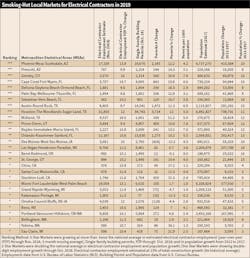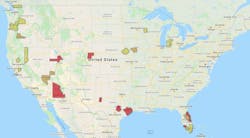In the November 2018 issue of EC&M, the article “Market Planning Made Easy” offered tips on how electrical contractors can develop a business plan with their favorite electrical distributors to jointly grow revenues in 2019. The article showed readers where to find free information on local trends in employment and populations, and where to look for information on construction projects.
While the most important part of your annual strategic planning process is to analyze the local market or markets that account for most of your business, it’s also a good idea to know how your local market stacks up against other metropolitan areas in your state by looking at economic indicators such as electrical contractor employment, single-family building permits and population. Electrical contractors that focus on the industrial market should also track manufacturing employment. All the employment data you will need is available for free at the U.S. Bureau of Labor Statistics (BLS) (www.bls.gov), while local data for population and building permits is available from the U.S. Census Bureau (www.census.gov).
The Table offers the results of our analysis of these indicators for more than 300 Metropolitan Statistical Areas (MSAs) to see which ones are outperforming the national averages. For the purposes of this article, we selected local markets enjoying year-over-year (YOY) growth at twice the national growth rate for electrical contractor employment, population, and single-family building permits. Consider doing the same for the geographic market areas in your state so you can see which metros are growing the fastest.
Going through this exercise may reveal some new growth opportunities for your business in nearby market areas that had previously not been apparent. In our analysis, we found 11 MSAs out of the more than 300 in the United States that were growing at twice the national rate in all three key indicators (electrical contractor employment, single-family building permits, and population), and six more metros with two of the indicators (contractor employment and population) growing at that lofty rate. The chart also highlights 12 MSAs with electrical contractor employment growing at a double-digit YOY clip through October 2018.
It’s not too surprising that five states accounted for all the metros with Three-Star Ratings — Arizona, Colorado, Florida, Texas, and Utah — because over the past few years MSAs in these states have regularly been at the top of our analyses for fast-growing markets throughout the nation. And if you look through the list, you will find that Florida accounts for nearly a quarter of all markets on the list. States in the Sunbelt, along the West Coast and in the Intermountain region (Colorado, Idaho, Utah, etc.) have perennially been among the leaders in market growth and potential for electrical contractors and other players in the electrical industry. Let’s take a closer look at the market areas with truly stellar economic metrics that point toward some solid growth in 2019.
Electrical contractor employment. The markets outpacing the U.S. national electrical contractor employment growth rate (through November 2018) of +4.1% include Midland, Texas (+19.5%); Phoenix (+13.8%); Omaha-Council Bluffs, Neb.-Iowa (+12%); Houston (+12%); Stockton-Lodi, Calif. (+11.6%); Las Vegas (+11.2%) and Reno, Nev. (+10.5%); Portland, Ore. (+10.1%) and Greeley, Colo. (+10%). Worth noting are the spectacular YOY increases in the Phoenix-Mesa-Scottsdale MSA (+2,202 estimated new electrical contractor employees), and the Houston-The Woodlands-Sugarland MSA (3,415 new employees).
Building permits. Of the 25 MSAs that logged the most single-family building permits through October 2018, these metros had the highest YOY growth: Phoenix-Mesa-Scottsdale, Ariz., 19,676 permits (+12.2%); Austin-Round Rock, Texas, 14,541 permits (+11.3%); Orlando-Kissimmee-Sanford, Fla., 13,830 permits (+10.2%); Tampa-St. Petersburg, Fla., 12,247 (+11.3%); Denver-Aurora-Lakewood, Colo. 10,338 permits (+12.8%); Riverside-San Bernardino-Ontario, Calif., 9,753 (+11.8%); and Jacksonville, Fla., 9,351 (+12.4%).
Population. You typically uncover some familiar names with this metric, which is another good indicator of a market’s economic health. The Austin-Round Rock MSA has had a 15% population increase over the past five years, adding 281,261 new residents, according to data from the U.S. Census Bureau. When measured by percent increase over this period, some other metros at the top of the list include Bend-Redmond, Ore. (+16%, +25,532 residents); Greeley, Colo. (+15%, +40,879 residents); St. George, Utah (+15%, +21,446); and Provo-Orem, Utah (+12%, 67,604 residents).
Your local market area might not match some of the blue-chip economic metrics these high-flying MSAs enjoy, but measuring your local market area with the economic indicators mentioned in this article against other metros in your region and against state and national averages will give you a sense of how your market’s 2019 business prospects compare with other metros.
About the Author
Jim Lucy
Editor-in-Chief, Electrical Wholesaling & Electrical Marketing
Over the past 40-plus years, hundreds of Jim’s articles have been published in Electrical Wholesaling, Electrical Marketing newsletter and Electrical Construction & Maintenance magazine on topics such as electric vehicles, solar and wind development, energy-efficient lighting and local market economics. In addition to his published work, Jim regularly gives presentations on these topics to C-suite executives, industry groups and investment analysts.
He launched a new subscription-based data product for Electrical Marketing that offers electrical sales potential estimates and related market data for more than 300 metropolitan areas. In 1999, he published his first book, “The Electrical Marketer’s Survival Guide” for electrical industry executives looking for an overview of key market trends.
While managing Electrical Wholesaling’s editorial operations, Jim and the publication’s staff won several Jesse H. Neal awards for editorial excellence, the highest honor in the business press, and numerous national and regional awards from the American Society of Business Press Editors. He has a master’s degree in communications and a bachelor’s degree in journalism from Glassboro State College, Glassboro, N.J. (now Rowan University) and studied electrical design at New York University and graphic design at the School for Visual Arts.



